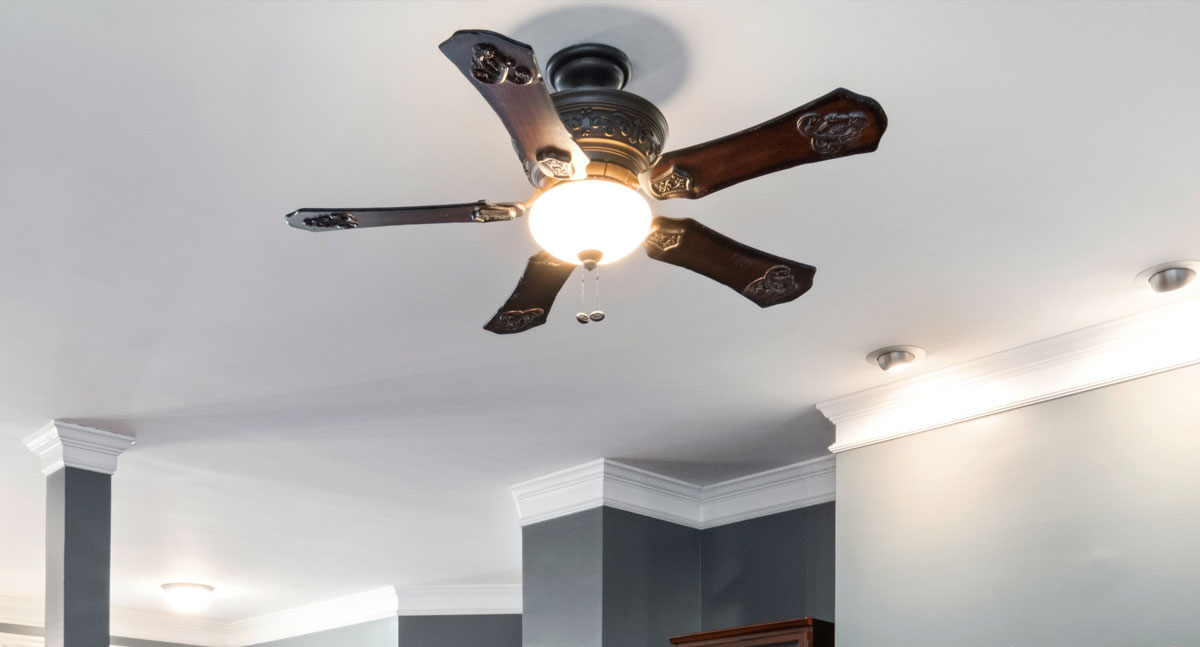A poorly placed fan is noisy and doesn’t cool you, making your room uncomfortable.
Getting the height right is the simple solution to ensure safety and perfect airflow.
For optimal performance and safety, ceiling fan blades must be at least 7 feet (2.13 meters) from the floor.
The ideal height for the best airflow is between 8 and 9 feet (2.44 to 2.74 meters) from the ground.
Also, ensure there are at least 8 to 10 inches (20.32 to 25.4 cm) of space between the ceiling and the blades.
Knowing the ideal height is the first step.
But how do you achieve that with different ceilings in your home?
It depends on choosing the right parts for your specific space.
Let’s dive into how to get it just right.
Find Your Perfect Ceiling Fan Downrod Length
You bought a new fan, but the included rod is too short for your high ceiling.
Now the fan looks strange and barely moves the air.
A different downrod is the answer.
To find your downrod length, measure your ceiling height in feet and then subtract 9 feet (2.74 meters).
The result is the recommended downrod length in inches.
This simple calculation helps you achieve the ideal fan height for comfort and efficiency.
A downrod is the metal pipe that connects the fan’s motor to the mounting bracket on the ceiling.
Its entire purpose is to set the fan’s hanging height, which is crucial for both performance and safety.
Choosing the right length is one of the most important decisions you’ll make during installation.
A fan that is lowered to the correct height circulates air more effectively throughout the living space.
This improves your comfort and helps the fan operate at its full capacity, preventing air from getting trapped near the ceiling.
How to Calculate the Right Length
The formula is straightforward and easy to use.
It ensures your fan ends up in that ideal 8-to-9-foot (2.44 to 2.74 meters) zone above the floor.
Ceiling Height (in feet) - 9 feet = Recommended Downrod Length (in inches)
For example, if your ceiling is 12 feet (3.66 meters) high: 12 feet - 9 feet = 3 feet You would convert the 3 feet (0.91 meters) to inches, meaning you need a 36-inch (91.44 cm) downrod.
For quick reference, here is a guide to help you select the right downrod based on your ceiling height.
| Ceiling Height | Recommended Downrod Length |
| 7 ft – 9 ft (2.13 – 2.74 m) | Flush mount or a 6” (15.24 cm) downrod |
| 10 ft – 12 ft (3.05 – 3.66 m) | 12” to 24” (30.48 to 60.96 cm) downrod |
| 13 ft – 15 ft (3.96 – 4.57 m) | 36” to 48” (91.44 to 121.92 cm) downrod |
| 16 ft – 17 ft (4.88 – 5.18 m) | 50” to 60” (127 to 152.4 cm) downrod |
Most fans come with a standard mount that includes a short 3-to-5-inch (7.62 to 12.7 cm) downrod, which is perfect for 8-foot (2.44-meter) ceilings.
For anything taller, you will need an extended mount, which just means you are buying a longer downrod separately.
These can range from 6 inches (15.24 cm) all the way to 120 inches (304.8 cm) for very high or vaulted ceilings.
Ceiling Fan Sizing and Height Guide
Choosing a new ceiling fan can be confusing.
A fan that’s too small won’t move enough air in your room, while one that’s too big can be overwhelming.
Let’s find the perfect fit.
First, measure your room’s square footage by multiplying its length and width.
Then, match that size to a fan.
For example, a small room up to 75 sq. ft. (6.97 sq. meters) needs a 29-36 inch (73.66-91.44 cm) fan, while a large room up to 400 sq. ft. (37.16 sq. meters) needs a 50-54 inch (127-137.16 cm) fan.
Getting the right size and height combination is essential for performance.
A fan that is correctly sized for the room will circulate air efficiently, keeping you comfortable without wasting energy.
Step 1: Measure Your Room
Before you start shopping, figure out the size of your room.
Take a tape measure and find the length and width of the room.
Then, simply multiply the two numbers together to get the total area in square feet.
Room Length (in feet) x Room Width (in feet) = Room Size (in square feet)
Step 2: Match Room Size to Fan Size
Once you know your room’s square footage, you can choose a fan with the right blade span.
The blade span is the diameter of the circle the blades make when they spin.
Using a fan that’s properly sized for the room ensures balanced and effective cooling.
| Room Size (Square Feet) | Suggested Fan Blade Span |
| Up to 75 sq. ft. (6.97 sq. m) | 29-36 inches (74-91 cm) |
| 76-144 sq. ft. (7.06-13.38 sq. m) | 36-42 inches (91-107 cm) |
| 144-225 sq. ft. (13.38-20.9 sq. m) | 44 inches (112 cm) |
| 225-400 sq. ft. (20.9-37.16 sq. m) | 50-54 inches (127-137 cm) |
Step 3: Consider Your Ceiling Height
The height of your ceiling directly impacts what type of fan or mount you can use.
- Low Ceilings (Under 8 feet / 2.44 meters): You must use a flush-mount or hugger style fan. These fans attach directly to the ceiling without a downrod, maximizing the space between the blades and the floor.
- Standard Ceilings (8 to 9 feet / 2.44 to 2.74 meters): A standard fan with a short downrod (usually included) is your best bet. This allows the fan to hang at a safe height while still providing good airflow.
- High Ceilings (Over 9 feet / 2.74 meters): You will need to buy a longer downrod to lower the fan. This brings it down to the optimal 8-to-9-foot (2.44 to 2.74 meters) height from the floor, ensuring the air actually circulates where you can feel it.
Is Your Ceiling Fan Hung Too Low or High?
Your fan is installed, but something feels off.
Maybe it’s making a strange noise, or you’re not feeling much of a breeze.
The installation height could be the culprit.
A fan is hung too low if its blades are less than 7 feet (2.13 meters) from the floor, creating a serious safety hazard.
It is hung too high if it is so close to the ceiling that it wobbles or cannot circulate air effectively through the room.
The proper placement of your ceiling fan is a balance between safety and performance.
Deviating from the recommended height standards can lead to a number of problems, turning your helpful home feature into a frustrating issue.
Understanding the risks associated with incorrect height can help you get the installation right the first time.
The Dangers of a Low-Hanging Fan
Safety is the number one reason for height regulations.
The rule is that the lowest point of the fan blades must be at least 7 feet (2.13 meters) above the ground.
This is a critical safety standard, not just a suggestion.
It ensures that a person of average height can walk underneath without any risk of being hit by the moving blades.
If a fan is installed too low, it becomes a significant accident risk, especially in homes with children or in high-traffic areas.
You should probably avoid installing a standard fan in any room with a ceiling that is too low to meet this 7-foot (2.13-meter) clearance.
The Inefficiency of a High-Hanging Fan
While a fan hung too high isn’t a safety risk, it will not perform its job well.
For a fan to move air, it needs space to pull air from above it.
The blades should be positioned 8 to 10 inches (20.32 to 25.4 cm) from the ceiling for efficient airflow.
If a fan is installed too close to the ceiling (like some flush mount models), there isn’t enough space for proper air intake.
This leads to very weak airflow and poor circulation.
Furthermore, placing the fan too close to the ceiling can create air turbulence, which may cause the fan to wobble, make noise, and operate less efficiently.
This completely undermines the fan’s ability to cool the room.
❗ Caution Fans that aren’t rated for outdoor use should never be used outdoors. Check the manufacturer’s specifications to ensure the fan you’re considering is appropriate for the space.
5 Tips for Optimal Ceiling Fan Placement
You know the right height and size, but where exactly in the room should the fan go?
Placing it in the wrong spot can ruin its effectiveness and look unbalanced.
Let’s ensure you get it just right.
For the best performance, always mount your fan in the center of the room.
Make sure the blades are at least 18 inches (45.72 cm) from any wall and have a top clearance of 8 to 10 inches (20.32 to 25.4 cm) from the ceiling.
Beyond just the vertical height, the fan’s position within the room is key to its function.
Proper placement ensures even air distribution, safety, and a balanced look.
Following a few simple guidelines for clearance on all sides will help you maximize your fan’s potential.
Tip 1: Find the Room’s Center
This is the most fundamental rule of fan placement.
A fan installed in the middle of the room will distribute air evenly to all corners.
If you place it off-center, one side of the room will get a strong breeze while the other gets almost nothing.
Tip 2: Check All Your Clearances
Think of clearance in three dimensions:
- Floor Clearance: This is the most important safety rule. The blades must be a minimum of 7 feet (2.13 meters) from the floor. No exceptions.
- Wall Clearance: The tips of the fan blades should be at least 18 inches (45.72 cm) away from any wall or curtain. For larger fans (44 inches / 111.76 cm or more), a side clearance of 24 inches (60.96 cm) is even better for air circulation.
- Ceiling Clearance: This is critical for airflow. A gap of 8 to 10 inches (20.32 to 25.4 cm) between the ceiling and the top of the blades allows the fan to pull in air without turbulence.
Tip 3: Watch Out for Obstructions
Consider other items in the room.
Airflow can be blocked by tall furniture like entertainment centers, bunk beds, or even large light fixtures.
As a general rule, try to keep at least 3 feet (0.91 meters) of clearance between the fan blades and the tallest obstruction in the room.
Tip 4: Plan for Year-Round Use
Your fan can help with heating in the winter, too.
For summer, the ideal 8-to-9-foot (2.44 to 2.74 meters) height creates a direct, cooling downdraft.
For winter, you reverse the fan’s direction.
A fan that is closer to the ceiling is actually better for winter use, as it gently pushes the warm air trapped at the ceiling down the walls without creating a chilly breeze.
Tip 5: Adapt for Special Situations
Not all ceilings and locations are the same.
- Sloped or Vaulted Ceilings: You must use a special sloped mount adapter. This hardware allows the fan to hang level, preventing strain on the motor and ensuring it operates smoothly without wobbling.
- Low Ceilings (under 8 feet / 2.44 meters): Your only safe option is a hugger or flush-mount fan. These fans are designed specifically to mount directly against the ceiling, giving you maximum headroom.
- Outdoor Locations: For patios, pergolas, or gazebos, you must use a fan specifically rated for the outdoors. Damp-rated fans are for covered areas safe from direct rain, while wet-rated fans can handle direct exposure to the elements.
💡 Tip An outdoor ceiling fan with a remote will save you from having to get up to adjust the fan or fan light while relaxing outdoors.
Conclusion
Installing your fan at the right height is about more than just following rules.
It is the key to maximizing safety, improving comfort, and ensuring your fan works efficiently for years.
Frequently Asked Questions
1. Can you install a ceiling fan on an 8-foot (2.44-meter) ceiling? Yes, an 8-foot (2.44-meter) ceiling is a standard height.
Most fans come with a short downrod that positions the fan correctly for both safety and good airflow.
2. How do you reverse a ceiling fan’s direction for winter? Most fans have a small toggle switch on the motor housing.
In summer, the blades should spin counter-clockwise for a cooling breeze.
In winter, flip the switch so they spin clockwise.
3. Do longer downrods make a ceiling fan wobble? A longer downrod does not cause wobbling if the fan is properly balanced and installed on a securely mounted electrical box.
Wobbling is usually caused by unbalanced blades or a loose installation.
4. How far should fan blades be from the nearest wall? For proper air circulation and safety, fan blades should be at least 18 inches (45.72 cm) away from any wall or obstruction.
5. Do flush mount fans move less air? Yes, because the blades are very close to the ceiling, they cannot pull in as much air as a fan on a downrod.
They are a trade-off between maximizing headroom and airflow.
6. Can I use an indoor fan on a covered patio? No, you should only use fans specifically rated for outdoor or damp locations.
Indoor fans have components that can rust or warp from humidity, creating a safety hazard.
7. Does the number of blades on a fan matter? While it affects the style, the number of blades has less impact on airflow than the blade pitch and motor power.
More blades can sometimes lead to a quieter operation.







